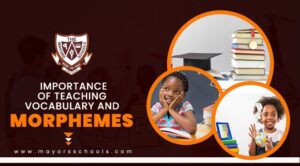The teaching of vocabulary and morphemes.
How do you teach a tricky new word, or seek to boost the word hoard of the pupils you teach?

Morphology is one of the most common approaches to developing academic vocabulary. It breaks words down into their component parts and roots. A rich network of new word families can be built as well as academic vocabulary in subjects like science that are laden with technical vocabulary.
It is an approach as ancient as the Greek and Latin societies that generated so many of the words that clothe our modern-day school curriculum. New research keeps adding to the picture that this is an approach teachers should consider as part of essential classroom practice.
A small recent US study on, ‘What’s in a word? Effects of morphologically rich vocabulary instruction on writing outcomes among elementary students’ (2022), revealed that young children who were taught with a morpheme focus to their instruction made gains with spelling and understanding word meanings, though it was less effective when judging essay writing (a much bigger challenge, where word knowledge and choices may be compromised).
The second recent study on morphology teaching, entitled ‘Growth in written academic word use in response to morphology-focused supplemental instruction’ (2022), showed that for older primary school age US pupils, they developed an increase in academic word use across two terms when given morphology instruction compared to business as usual. Interestingly, pupils who struggled with literacy didn’t make as many gains – which should give us pause.
How often does the word rich get richer, no matter our attempts?
It doesn’t rule out teaching vocabulary using morphology, but we should recognize that some pupils will still struggle to develop academic vocabulary and they need our additional support to access the curriculum. Breaking words into their component parts can simplify the complex act of getting to grips with academic language, but trailing and testing it in the crucible of the classroom will matter.
What practical approaches can mobilize morphology teaching? Here are 4 Mighty Morpheme strategies:
Root Races (or ‘Spelling sprints’). Pupils enjoy being exposed to new word roots and making a race for generating as many words from that root as possible. Take the root ‘Magni’, meaning ‘great’. We give pupils a minute or two to generate as many words as possible (individually or in groups). Think ‘magnificent’, ‘magnanimous’, ‘magnitude’ and ‘Magna Carta’. Then, after some counting of words, we can explore their connections and meanings and create rich academic word families.
Word trees: A popular approach to exploring word families is to generate word trees. Websites like Membean.com do a great job of generating these, but it can be equally as good to generate them on a classroom display, or together as a class on the whiteboard (this can be planned, or spontaneous, if the pupils detect some meaningful morphology.
Making morphemes visible: A lively way to generate ideas is to hold back on the word root, but instead to share three images that all represent words connected by their common roots. For instance, what do the following three images represent?
Word building: For the very youngest of children, all the way up to A level, we can develop vocabulary via word building. It has many variants, but the kernel of the approach it to select prefixes (e.g. ‘un’, ‘re’ or ‘exo’) along with word roots (e.g. ‘tract’, ‘feat’ etc.) and suffixes (‘ed’, ‘ing’ etc.) and encouraging word building. You can even have fun making up some nonsense words!
Credit Source: The Confident Teacher

this is really educative thanks for sharing this article